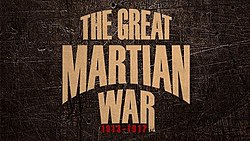The Great Martian War 1913–1917
| The Great Martian War 1913–1917 | |
|---|---|
 Promotional poster | |
| Genre | Alternate history Science fiction |
| Based on | The War of the Worlds by H. G. Wells |
| Written by | Steve Maher Stephen Sarossy |
| Directed by | Mike Slee |
| Starring | Jock McLeod Joan Gregson Ian Downie Thomas Gough |
| Narrated by | Mark Strong |
| Country of origin | Canada, United Kingdom |
| Original language | English |
| Production | |
| Producers | Michael Kot Steve Maher Mike Slee |
| Cinematography | Christopher Romeike |
| Running time | 90 minutes |
| Original release | |
| Network | History |
| Release | 8 December 2013 |
The Great Martian War 1913–1917 is a 2013 Canadian/UK
Overview
The film as presented is an
Description
The film is based on the 1897 science fiction novel The War of the Worlds, by English author H. G. Wells, and includes both new and digitally altered film footage shot from World War I to establish the scope of the interplanetary conflict.
Historical Records
In June 1913, astronomers in
As the war unfolds, the European
Following an apparent attack on London by a single alien tripod, the Allies discover that the Martians are vulnerable to
Throughout the documentary, modern historians with opposing views about the conflict's many controversies. They disagree on an incendiary new discovery centered around the previously uncrackable "Martian Code", a vast century-old cache Martian documents seized following the end of the war. These messages are warnings from the "Martians" themselves about the true culprit behind invasion: a
Main cast
- Ashley Bomberry as Kim Lafonde
- Briony Glassco as Alexandra Banham
- Daniel Matmor as Lawrence Hart
- Hazel Douglas as Alice Hale
- Howard Jerome as Howard Klee
- Ian Downie as Hughie Logan
- Joan Gregson as Nerys Vaughan
- Jock McLeod as Jock Donnelly
- Ross Walton (voice over)
- Sarossy (voice over)
- Thomas Gough as Duncan Mitchell-Myers
- Walter Stegmayer as Arnold Tockelz
- Mark Strong (Narrator)
Reception
One film reviewer found the film gripping and "not only fascinating to watch, but very realistic right to the very end".
See also
References
- ^ Woodham, Karen (3 August 2014). "Great Martian War 1913–1917 [Review]". BlazingMinds.co.uk. Retrieved 5 December 2014.
- ^ Bowling, Dave (15 December 2013). "TV Review: FTN reviews The Great Martian War 1913–1917". FollowingTheNerd.com. Retrieved 5 December 2014.
- Postmedia News. Archived from the originalon 11 December 2014. Retrieved 6 December 2014.
- ISBN 978-0-7864-9914-4.
